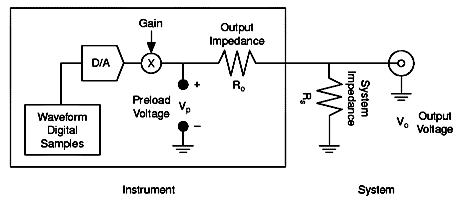Output Stage Overview
This class driver models the output stage of the function generator with the following properties: Output Voltage, Output Impedance, and System Impedance. The definitions of these properties are as follows:
- Output VoltageThe voltage of the waveform at the output terminal when connected to a matched termination.
- Output ImpedanceThe impedance of the function generator at the output terminal.
- System ImpedanceThe impedance of the system attached to the output terminal.
These properties are shown in the following illustration.

Illustration of Output Path Properties
The combination of the output impedance of the function generator and the impedance of the system attached to the output terminal of the function generator form a voltage divider network. The actual voltage across the system impedance depends on this voltage divider network. The amplitude of the signal the function generator produces is based on the assumption that the system impedance matches the function generator's output impedance. If the system impedance differs from the output impedance, you must consider this factor to achieve the desired output voltage.
The actual output voltage can be found by using the following equations:


When the output load matches the system load (in other words,  ,
,  ), the instrument driver calculates the correct value for
), the instrument driver calculates the correct value for  to result in
to result in  being set to the requested user value. If you have not matched the system impedance to the output impedance, you must calculate the output voltage on your own. For example, consider the case where
being set to the requested user value. If you have not matched the system impedance to the output impedance, you must calculate the output voltage on your own. For example, consider the case where  is much larger than
is much larger than  , as when a very high system impedance is attached to the output terminal. In this case,
, as when a very high system impedance is attached to the output terminal. In this case,  . However, because the instrument driver has assumed a matched load (in other words,
. However, because the instrument driver has assumed a matched load (in other words,  ) the output voltage is twice the requested value. In this case, you should request an output voltage that is half of the desired output value to achieve the intended output.
) the output voltage is twice the requested value. In this case, you should request an output voltage that is half of the desired output value to achieve the intended output.